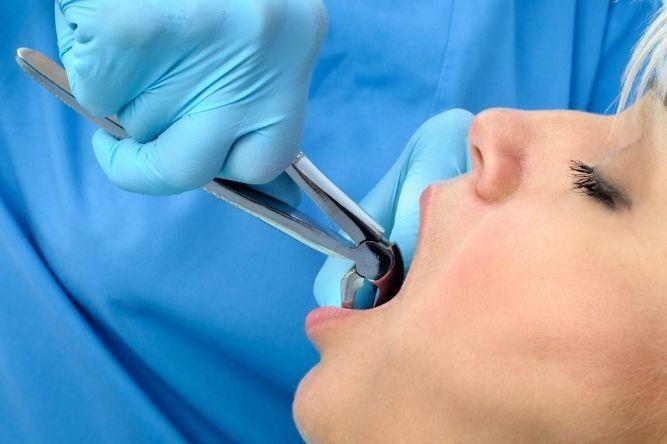You never want to lose a tooth, but an extraction may be the only way to prevent an infection from spreading. And if you have an impacted wisdom tooth, a surgical extraction will keep it from damaging other molars.
You might feel a bit uneasy about your upcoming extraction. Relax. When you’re in the care of our experienced dentists, you have nothing to worry about.
At Affinity Dental, we do everything we can to save your tooth. But in some cases, the best solution may be an extraction. We’re going to walk you through the extraction process, from the procedure itself to the healing process. Here’s what you need to know:
The Extraction Process
You’ve probably had your teeth cleaned or a cavity filled before, but what about getting a tooth pulled? First, we’re going to clarify what to expect with each type of tooth extraction:
Simple extractions are performed when the tooth has emerged above the gumline. After you receive an anaesthetic to numb your mouth, the dentist will use an elevator to loosen the tooth. Then, they remove it using forceps. You should not feel any pain during the extraction, but you can expect to feel some pressure as the tooth is being removed.
Surgical extractions are a bit more complicated. These are necessary when the tooth is below the gum line, which is often the case with wisdom teeth. After the anaesthetic takes effect, the dentist will make an incision in the gums. Then, they’ll remove the wisdom tooth or shards of the broken tooth. They may need to cut away some bone or gum tissue to access the area.
Once you have your tooth removed, your procedure is complete! Your oral surgeon will apply a gauze pad to help with the bleeding. We strongly recommend that you arrange for a ride home; it’s dangerous to operate a motor vehicle after receiving IV sedation.
Will It Be Painful?
At Affinity Dental, we aim to minimize any pain during your procedure. We do this by using general or local anaesthesia, which numbs your nerves and promotes feelings of calmness.
Once the anaesthetic wears off, you may feel more pain. If you’re dealing with discomfort after your procedure, try to reduce swelling using ice packs.
When you get a tooth extraction in Winnipeg at Affinity Dental, we’ll discuss your sedative options to determine what’s right for you.
How Long Does Recovery Take?
On average, the healing process typically takes one to two weeks. However, the extraction site itself may take a few weeks to heal completely.
While you’re recovering, you can brush and floss your teeth as usual—just take care to avoid the extraction site. A saltwater rinse is a great way to clean the surgical site (just be sure to wait at least 24 hours after the procedure). Take a cup of warm water (not hot), and mix in a teaspoon of salt. Next, gently rinse your mouth with the saltwater solution.
Want to speed up the healing time? We’ve put together a few tips for you:
- Eat soft foods. For the next few weeks, put away those crunchy chips and tough meats. It’s best to stick to soft foods while you’re recovering from an extraction. Otherwise, you may dislodge the blood clot at the extraction site. Instead, consume foods like soup, smoothies, and scrambled eggs. Keep in mind that extreme temperatures will also cause discomfort; try to eat food that is room temperature.
- Avoid smoking. Smoking is harmful to your oral health in many ways, especially after an extraction. When you inhale from a vape or cigarette, it creates a vacuum in your mouth, which may dislodge the blood clot and create a dry socket. These can be incredibly painful and may slow the healing process. The pressure from sucking on a straw can also create a dry socket.
- Take it easy. Let your body recover in the days following your oral surgery. Avoid exercising while you’re healing. In addition, stay away from alcohol.
- Minimize pain. You can take pain medication as directed on the package to help with the swelling and discomfort.
Finally, make sure to avoid dislodging the blood clot. This is what forms in the tooth socket after you have the extraction. Blood clots protect the bone tissue and gum tissue. Be gentle with your mouth in the days and weeks after your extraction.
Warning Signs To Watch For
It’s perfectly normal to experience some pain after your procedure; most patients do. But what if your pain starts to cause severe discomfort?
As with any procedure, there may be complications with your tooth extraction. If you notice any of the following symptoms, contact your dentist immediately:
- Severe pain
- Numbness
- Excessive blood or pus
- Fever or flu-like symptoms
- Severe swelling
- Trouble breathing or swallowing
These symptoms may indicate that you are developing an infection. We recommend calling your dentist right away.
When To Schedule a Tooth Extraction
Is your tooth aching? You aren’t sure if you have a cavity, an infection, or a deeper issue that may require surgical treatment. You may need to have a tooth extracted if you have:
- Extensive tooth decay
- A tooth infection
- An impacted wisdom tooth
Wondering what to do after losing a tooth? Our dentists can help you replace missing teeth after tooth extractions. We can meet with you to discuss your options, from a dental implant to partial or full dentures.
Do You Need a Tooth Extraction?
Are you looking for a Henderson dentist to extract your tooth? At Affinity Dental, our experienced dentists are happy to help. We offer simple and surgical extractions to reduce your pain and protect your smile. To book your tooth extraction, contact us today!
